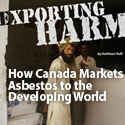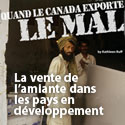Kathleen Ruff, RightOnCanada.ca
In an article in a Russian newspaper (translated below), the Deputy Director General of the Uralasbest asbestos mine expresses the hope that the IARC study at Uralasbest will put an end to any talk of banning asbestos.
Thousands of occupational histories in the research of the century
The best scientists, experts, epidemiologists and researchers of the world from France, Netherlands, United Kingdom and other countries have drawn their attention towards asbestos again. Now, however, the point is quite different: the scientists are not opposing the use of the mineral, but supervising a great research project carried out by Russian specialists and those from International Agency for Research on Cancer (IARC) in Uralasbest Plant. This research should be the most non-biased and independent in all factory’s history. The results will finally reveal if asbestos is really as harmful as it is supposed to be.
About the Research
This far-reaching research was initiated by Ministry of Health of Russian Federation which committed this task to Institute of Medicine of Russian Academy of Medical Sciences, headquartered in Moscow. Enumerating other organizations and institutions involved in the research would take the entire page. The main point is the result: internationally recognized experts became project supervisors.
Research project operating name is Studying Chronic Diseases Impacted by Asbestos among the Staff Employed in Extracting and Enriching Chrysotile Asbestos, through Retrospective Follow-up Study. The project began in 2011 and is supposed to have finished by 2015.
As a result, the scientists are to obtain non-biased data on chrysotile influence on human’s health. It is well-known that the attitude towards the topic ranges from aggressively negative to valiantly justifying. Each and every opinion is questionable and could be disputed: either incorrect methods were used, or the equipment and researcher qualification level didn’t correspond to the project goal. However, the present project implies an in-depth research under the best world experts’ supervision. The result obtained ought to be the closest to truth ever.
The essence of the research is occupational history analysis of all workers employed in extracting and enriching chrysotile asbestos for more than a year, including those who have already left the job, from 1975 up to 2010. An occupational history is actually the entire employee’s life during and after their employment period at the plant, up to their death, provided that it has already occurred. Each and every employee is identified by multiple parameters: first and last name, place of employment during different periods of life, asbestos dust level, total dust dosage received during the whole employment period, death cause (in case the person is dead). At this stage plant employees have identified 25,000 people so far: 11,000 are fully identified and 14,000 identifications are under follow-up revision.
Many Uralasbest departments and services are involved into data collection for researches, in particular Process Control Center, Central Production Control Laboratory, HR Department, Labor and Wages Department and OSH department. A special group for information search and data entry has been created. The group is headed by Izolina A. Smirnova.
First Results
While undertaking the research, regular meetings between plant workers and Agency for Research on Cancer (IARC) supervisors are organized. The latest meeting was held in early November. This is the second time a foreign delegation visits Uralasbest. The program was very varied and included excursions, meetings, discussions etc.
On November 8 Uralasbest held a conference where the scientists discussed the research project progress and workscope. On the delegation part the attendees were: Yevgeny Kovalevsky, leading researcher in Occupational Medicine Research Institute of Russian Academy of Medical Sciences (RAMS); Sergey Koshansky, head of Yekaterinburg Scientific Medical Center Laboratory; Joachim Kristoffer Schuz, head of International Agency for Research on Cancer (IARC) in France, and his colleagues, Sarah Schoenfeld and Monique Moissonnier. On the whole, the delegation consists of 11 members, among them there are such prominent researchers as Johannes Kromhout, Professor of Utrecht University (Netherlands), Anti Tossavainen, consultant (Finland), Alexander Akleyev, Director of Ural Research and Implementation Center of Medical Radiology (Federal Agency for Medicine and Biology, Russia), Igor Bukhtiyarov, Director of Moscow Institute of Occupational Medicine (RAMS) and others.
The conference was dedicated to discussing the results achieved in 2012, as well as to the plans for next year.
I consider these regular meetings supervising the course of work extremely important – Sarah Schoenfeld interpreted Joachim Kristoffer SCHUZ’s communication – It is very useful for us to be close to the process. We have noticed great progress in your research during 2012. The database you have managed to collect is the most significant tool to make others believe us. We all are lucky to have involved world-famous specialists in this project. We have prepared a detailed roadmap describing our future actions. Next year will be dedicated to data collection. We are to present primary analysis of dust content since 1930-s up to now. This is a crucial stage of our research.
Sarah Schoenfeld told about IARC employees’ reaction towards the data collected by people employed at the plant: “This is just incredible!” our colleagues exclaimed. “The cases when we have so much data are very rare!” Today, when I presented data to our Committee, a famous epidemiologist repeated those words “It is absolutely incredible, so much employee data is collected with most detailed occupation history descriptions! I have never seen anything like that before. Now we can initiate primary analysis in the Measurement Center.”
An interesting remark concerning research result interpretation was pronounced by Yevgeny Kovalevsky. It turns out that universal community assesses research results not by reports we’ve got so used to here in Russia, but by articles published in scientific magazines. If there are no articles, no actions were taken.
Hopes
“We don’t expect chrysotile asbestos to be proclaimed an absolutely benign mineral,” Vladimir A. Kochelayev, Deputy Director General of JSCo Uralasbest, shares his opinion. “However, we hope the research will be objective, putting an end to discussions on banning chrysotile.”
As a side note, Julian Peto, a famous professor in London School of Hygiene and Epidemiology, is also among delegation members. In 1999 he announced that “within 35 European population will reduce by 250,000 because of mesothelioma and more than by 500,000 as a result of lung cancer, caused by asbestos exposure”. 10 years passed but there are still no signs of this prediction to come true. In 2009 his attitude towards chrysotile significantly changed. During his presentation at Harvard Symposium dedicated to universal trends of mesothelioma death rate Peto mentioned that “exaggerating chrysotile health hazard distracts our attention from amphibole harmful nature”.
His report conclusions caused aggressive reactions from anti-asbestos lobbies side, which also included pickets and “battle-cries” like “Do not acknowledge Peto’s report!”. Nowadays Mr. Julian Peto is present at Uralasbest Plant and is delving into the subject. This is not the only example of foreign reporters changing their opinion towards the point.
On the whole, a heartening historical moment has come now, when European and Russian scientists are not on the opposite sides of the barricades, but, hopefully, share interest in an objective view on the question of safe and monitored chrysotile usage. Neither politics nor economy can serve as a base for of a non-biased research project. Only science and precise data can.
M. BATLUK Photo by the author



Tue, Apr 16, 2013
Asbestos